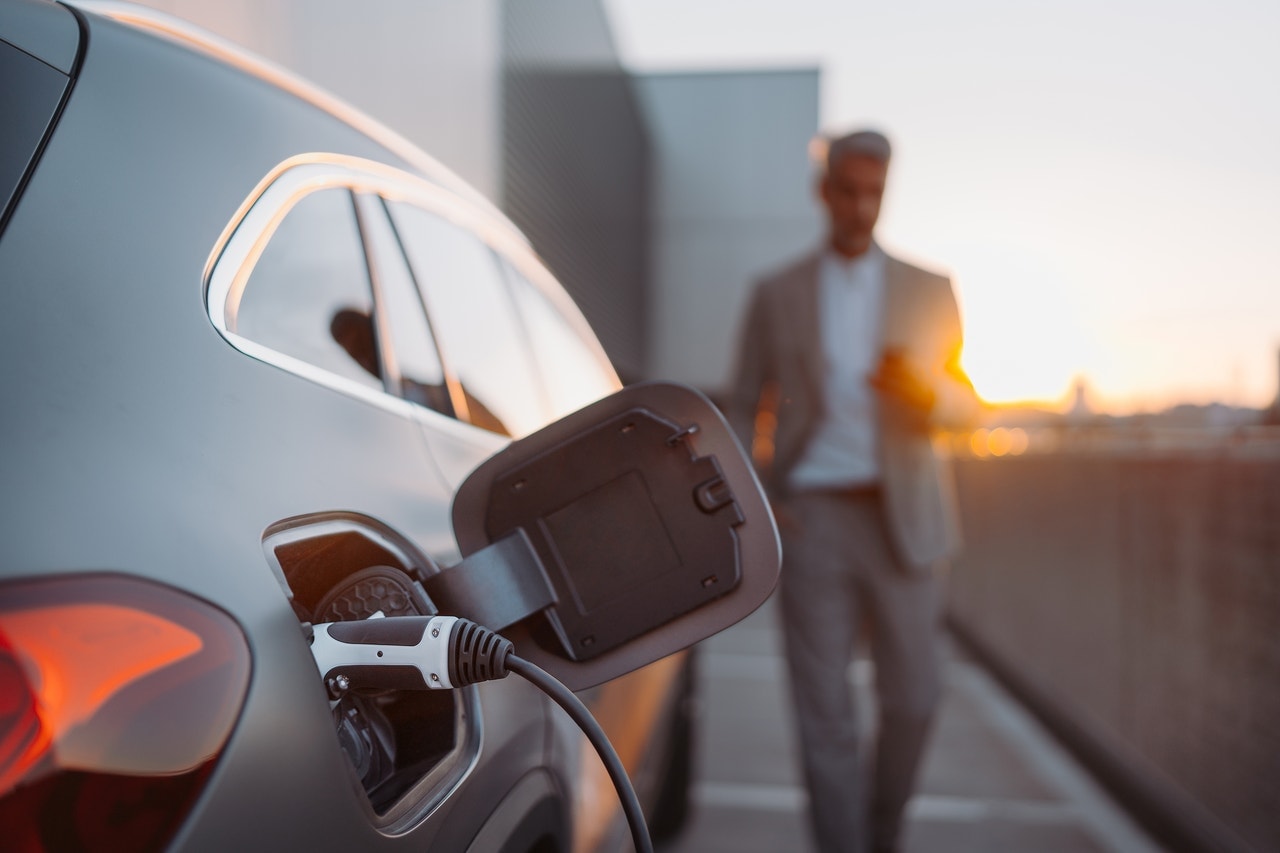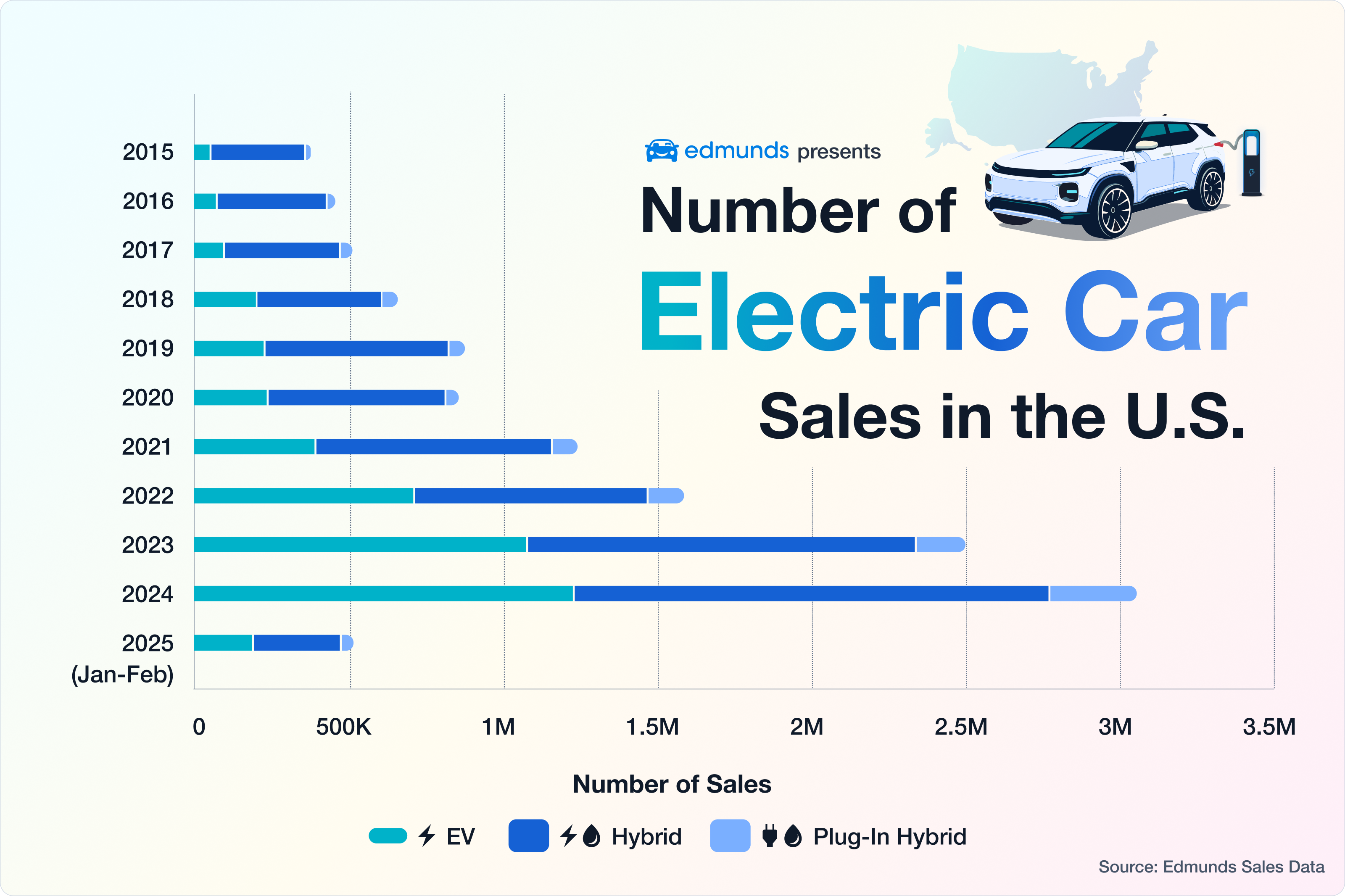Last year was another record-breaking year for EVs, with sales passing 1.2 million. EV sales could merely hold steady in 2025 because new vehicle prices are likely to increase due to tariffs on imported vehicles and parts and the possible rollback of federal EV incentives. Still, many automotive research firms expect EV sales to steadily grow into the 2030s. Below, we discuss past and current EV sales based on data collected from the experts at Edmunds. We also include hybrid and plug-in hybrid sales, as well as future EV sales projections.
Electric Car Sales
The latest EV sales data with infographic
Am I Ready for an EV?
- EV ownership works best if you can charge at home (240V outlet)
- Adding a home charging system is estimated to cost $1,616 in
- Edmunds is partnering with Treehouse, an independent provider of home EV installation services. Learn more about the installation services partnership
EV sales in the U.S. grew last year but could stall in 2025
In 2022, 713,145 EVs were sold, and that ballooned to a little over 1 million sales in 2023. EV sales increased again to 1.2 million in 2024, a gain that wasn't as high as expected. As of February of this year, 185,992 EVs have been sold. At this rate, EV sales might not grow this year. Since 2015, EV sales have increased every year and are significantly higher than the 389,410 sold just four years ago in 2021.
The market share — or the percentage of new vehicle sales — for EVs increased from 6.9% in 2023 to 7.7%in 2024. As of February, the EV market share is up slightly to 7.9%. In stark comparison, the EV market share was a paltry 0.3% in 2015, when the Nissan Leaf and Tesla Model S were two of the few electric options available.
Hybrid sales are surging, outpacing EV sales
There's a reason why many automakers are putting the brakes on their EV rollouts and have pivoted to increasing hybrid production: Hybrid sales are booming. Last year, 313,531 more hybrids were sold than EVs. ThroughFebruary of this year, 273,479 have been sold, which puts them on track to beat last year's sales. Hybrids will almost undoubtedly outsell EVs again this year.
Hybrid sales had their biggest surge from 2022 to 2023, increasing from 754,722 to a whopping 1,242,608. Last year, sales jumped to 1,546,989, which put the hybrid market share at 9.7%. Market share through February of this year is notably higher at 11.7%. Hybrid market share was 5% in 2021 and only 1.8% in 2015. We predict hybrid sales will continue to increase for the next several years.
Plug-in hybrids — also called plug-in hybrid electric vehicles or PHEVs — provide an electric driving range before they switch to operating like a regular hybrid when the battery runs low. Although sales are significantly lower than those of EVs and regular hybrids, 288,126 plug-ins were sold last year, the most ever. That's up from the 177K sold in 2023, the biggest year-over-year increase so far. The market share was only 1.8%last year and has so far stayed the same as of February. Plug-in hybrid market share was only 0.5% in 2021.
Total EV, hybrid and plug-in hybrid sales
The combined sales of EVs, hybrids and plug-in hybrids reached a little over 3 million in 2024, making up 19.2% of the market share. That's up from 2.5 million sales and 16% market share in 2023. Through February of this year, the market share has increased to 21.4% with 501,048 units sold. Sales of these three types of vehicles could hit 25% market share within the next two years.
ICE vehicle sales continue to dominate, but their market share is shrinking
Almost 13 million internal combustion engine vehicles, or ICE vehicles, were sold last year, constituting an overwhelming 80.8% of the market share. That's down from the 84% market share in 2023.Their market share decreased again to 78.6% through February of this year, with sales totaling1.8 million. The market share for ICE vehicles was 91.8% in 2021 and has dropped every year since 2015. We expect the market share of gas-engine vehicle sales to continue to drop as the popularity of EVs, hybrids and plug-in hybrids increases.
EV sales are projected to grow over the next several years
With tariffs expected to increase vehicle prices and reduce sales, along with the likely repeal of federal EV incentives, many automotive research and consulting companies have had to adjust their EV sales projections. Even so, EV sales are predicted to grow by 2030 and beyond. A recent report by J.D. Power forecasts that EV sales in the U.S. will hold at 1.2 million sales this year, but it predicts that the EV market share will hit 26% by 2030.
The Autovista Group, an automotive data and analytics company, released a recent report that says EVs will reach a market share of 39.2% in the U.S. and Canada by 2030. In 2035, the company projects that the EV share will increase to 70.7%. Based on what happens during the Trump administration, these predictions will likely continue to be adjusted.


 by
by .jpg) edited by
edited by